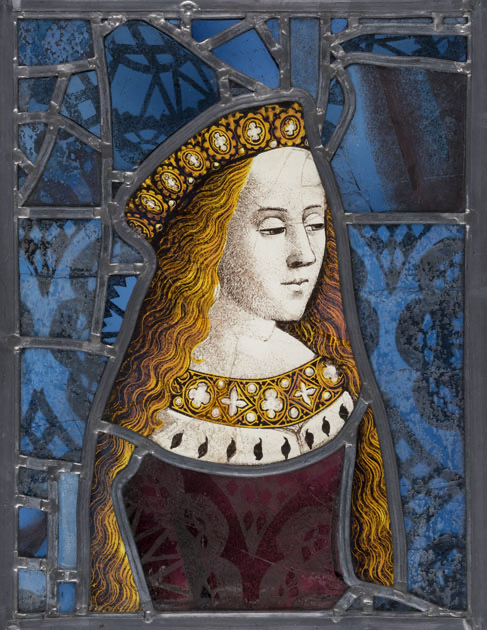
Stained glass portrait of Cicely. Formerly in Canterbury Cathedral now in the Burrell Collection, Glasgow.
Cicely Plantagenet (b.1469 d.1507) daughter and niece to kings, and a prime example of a medieval noblewoman who endured, and in this case survived, the turmoil of the Wars of the Roses. Oh how that fickle wheel of fortune spun for Cicely – like a human yoyo – up, down, up again and then a levelling off as she married for the third time . It’s no wonder Sir Thomas More would describe her as Not so fortunate as fair although this may be over egging the pudding a bit as she seems to have fared much better than some other aristocratic ladies from those times as two of her marriages appear to have been happy plus she didn’t die in penury as her mother did. After her third marriage she left England to live on the Isle of Wight, dying on the 24 August 1507. This last marriage is said to have made Henry Tudor, her brother-in-law, very, very annoyed. But more on that later.
Cicely’s early life was one of privilege most of her contemporaries would only ever have dreamed of. She lived the majority of her younger years with her siblings at Greenwich Palace, a favourite home for her mother, Elizabeth Wydeville, and which seems to have been used as a royal nursery for the brood of children she had borne Edward IV. Indeed it was while living at Greenwich on the 23 May 1482, Cicely’s 14 year old sister Mary died. This was the second death of a royal child at Greenwich in a matter of months for just six months earlier her even younger sister-in-law. the 8 year old Anne Mowbray, had died on 9th November 1481. Other times were spent at Westminster Palace when both parents were staying there.

An image of Greenwich Palace c.1487. Artist unknown. Now in the National Maritime Museum, Greenwich.

The Old Palace of Westminster. Westminster Abbey and Cheyneygates can be seen at the top of the picture.
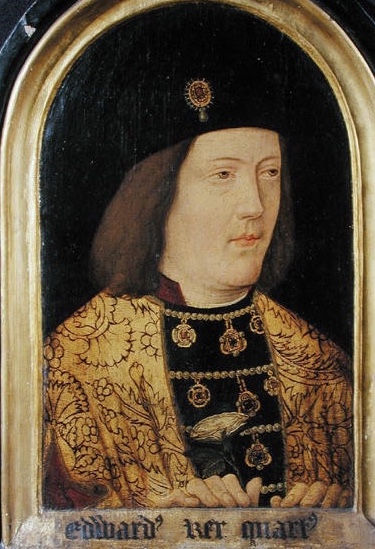
Cicely’s father Edward IV motto, ‘confort et lyesse’, 1442-1483 Society of Antiquaries of London
Tragedy, and disaster, struck in April 1483 when her father died rather unexpectedly at Westminster Palace. This led to a flurry of feverish activity from her mother and her Wydeville relations in a mad and unseemly scramble to get hold of the person of her brother Edward, now Edward V and living in Ludlow on the Welsh Marches. This was to enable them to gain control of the kingdom before Cicely’s uncle, Richard duke of Gloucester, took his rightful place as Lord Protector. When these plans went swiftly awry, the 14 year old Cicely and her siblings led by their mother, rushed off to sanctuary in Cheyneygates, the Abbots House, Westminster Abbey, where they would spend the next ten months. The Abbey and Cheyneygates were literally just across the road from the palace and, according to Sir Thomas More, in an attempt by the soon to be ex-queen, to take as much treasure and goods as possible with her, a hole was made in the wall of the Abbey.
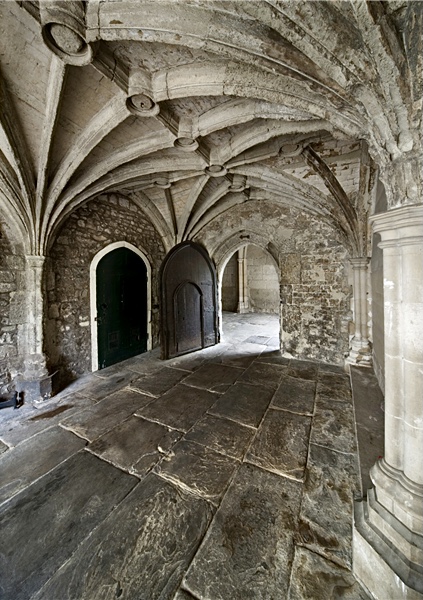
A view of the ancient passage way leading to Abbot’s Court and Cheyneygates. The family would have reached Cheyneygates via this passageway and trod these very flagstones..
What went through the mind of Cicely we can only speculate. But it must have been disconcerting at the very least – this sudden and drastic change in lifestyle – and no doubt she would have picked up on her mother’s mood, who was said by Sir Thomas More to have been found by Bishop Rotherham sitting ‘ alone, low down on the rushes, all desolate and dismayed’ – hardly a reassuring sight for her children.
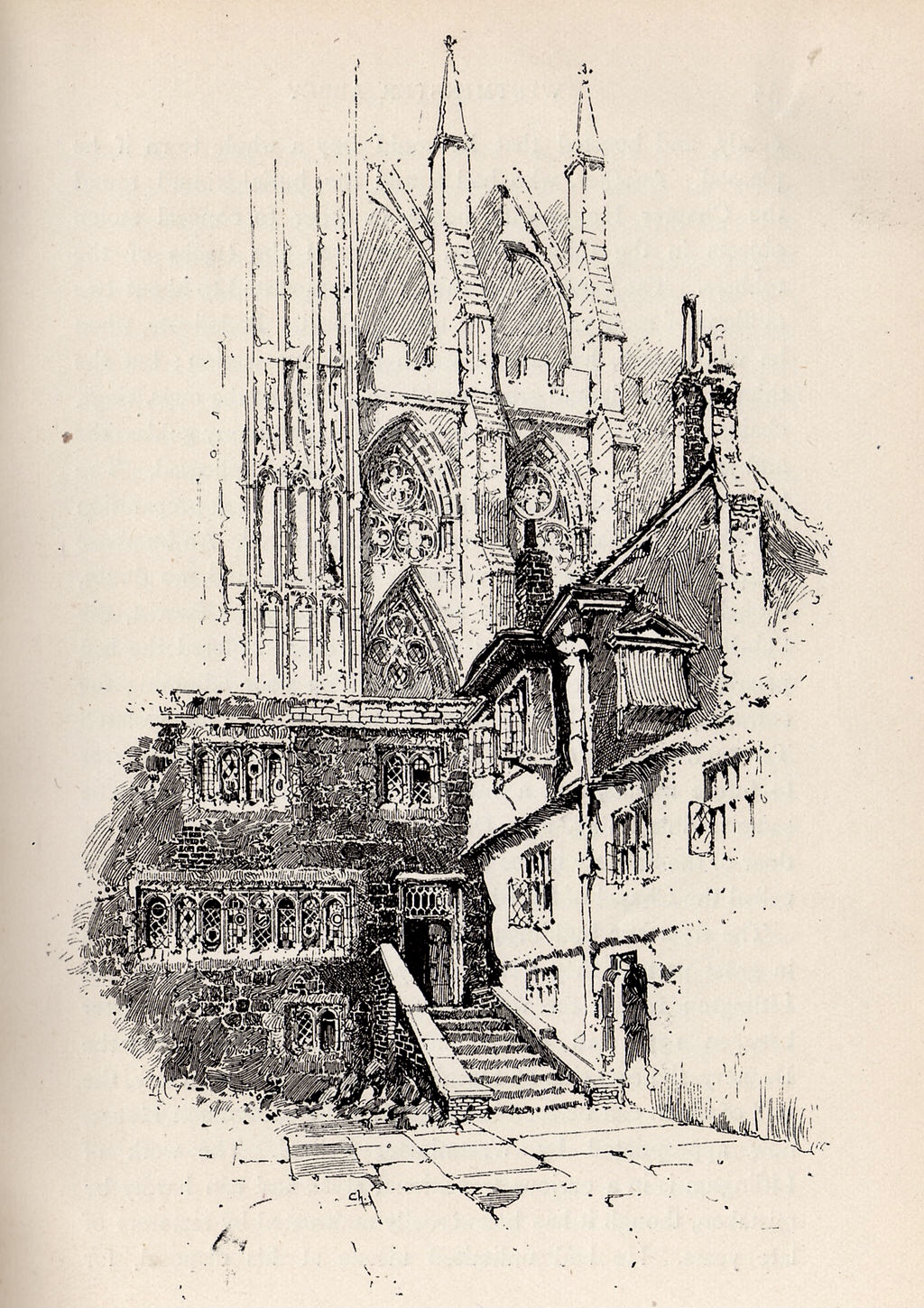
Jerico Parlour and Cheyneygates c1910. Jerico Parlour has hardly altered but the Abbots House known as Cheyneygates, to the right, where the Cicely and her family stayed has much changed over the centuries as well as suffering from bomb damage during the Blitz. Illustration by Herbert Railton.
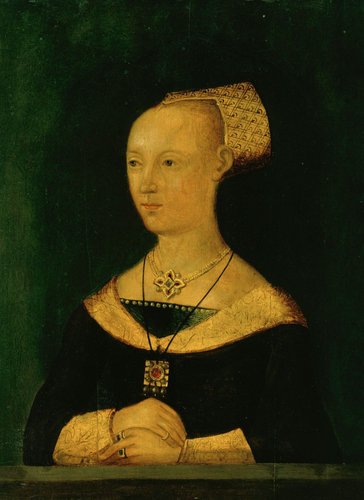
Cicely’s mother Elizabeth Wydeville, in her glory days before it all went pear shaped. This is the earliest known version of the many copies of a now lost original portrait of Elizabeth which was possibly from a likeness of her taken when she was alive. The Royal Collection
The long months in sanctuary must have seemed quite dour for the sisters and their brother even though the great hall, known as College Hall, had a minstrel gallery – they probably were not in the mood for music. Although undoubtedly the Abbots house would have been sumptuous, lack of space would have proven to be a problem for the royal, soon to be ex- royal, party. Was Cicely resilient and did she look forward to the day when she could leave that place and hopefully continue her former lifestyle? Or did she fear they were all going to die? Did the siblings bicker? Surely they must have picked up on the mood of their mother which could not have been inspiring if Sir Thomas More’s description of her is accurate. However Cicely’s mother’s state of mind must have reached an all time low on the morning of the 6th July 1483 when the loud clamouring of bells told them that Richard and his wife, Anne, were being crowned just yards away in the abbey.
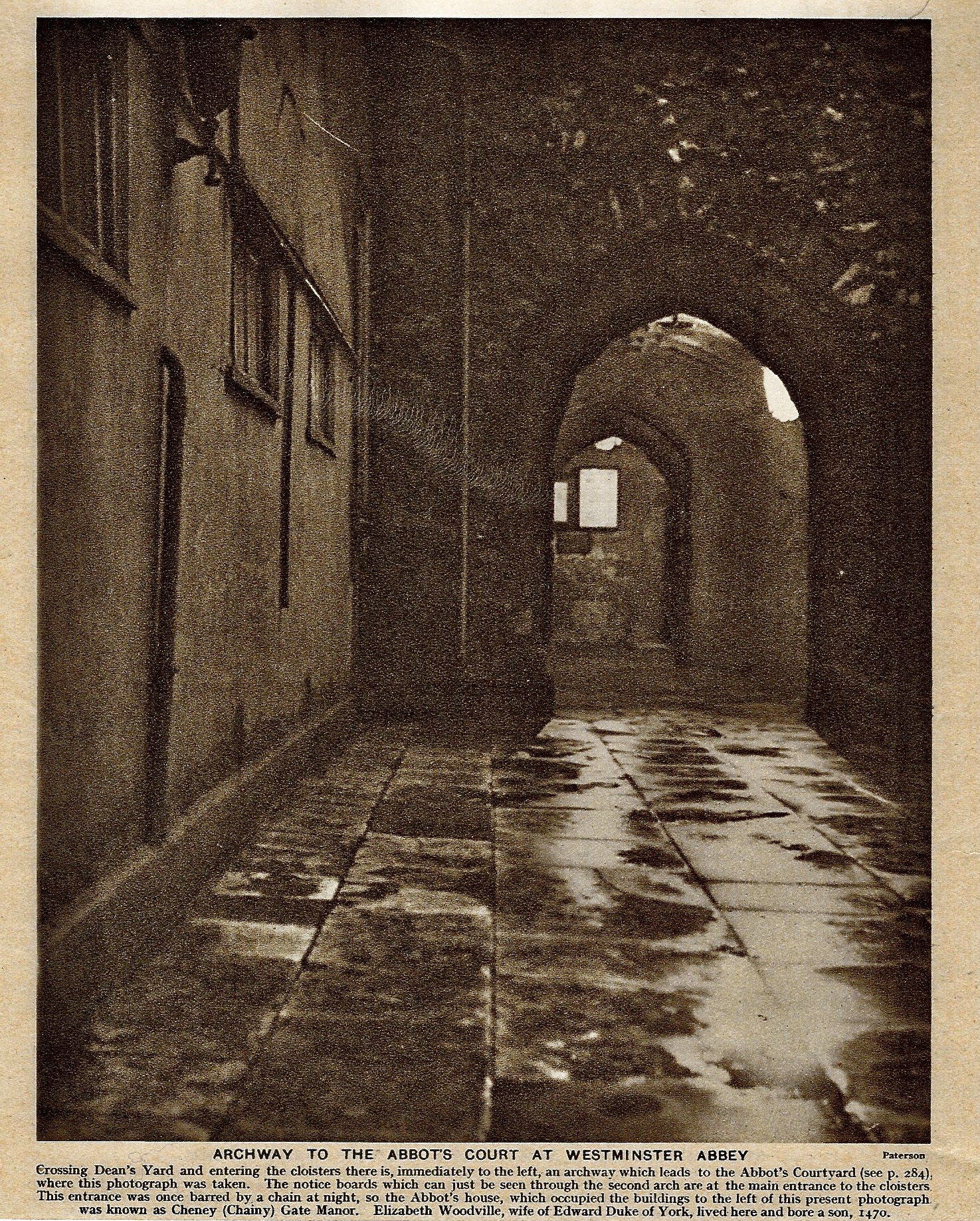
Old, atmospheric photo of the Archway in Abbots’s Court leading out and into the cloisters as well as the exit to the outside world. Cicely and her family would have gone through this ancient archway which has remained unchanged throughout the centuries to enter and leave Cheyneygates.,
Finally the day arrived when her mother, now known as Dame Grey, reached agreement with Richard, now King Richard III, and she and her sisters emerged into what must have been a much changed world. On the first day of Marche the first yere of my Reigne (1484) Richard had sworn an oath on holy relics that he would do no harm to Dame Grey’s daughters, and to seek good marriages for them with gentlemen and this is exactly what he was to do for both Cicely and Elizabeth.
Memorandum that I Richard by the grace of God King of England and of Fraunce and Lord of Irland in the presens of you my Lordes spirituelle and temporelle and you Maire and Aldermen of my Cite of London promitte and swere verbo Regio and upon these holy evengelies of God by me personelly touched that if the doughters of Dam Elizabeth Gray late calling herself Queen of England that is to wit Elizabeth Cecille Anne Kateryn and Briggette wolle come unto me out of the Saintwarie of Westminster and be guyded Ruled and demeaned after me then I shalle see that they shalbe in suertie of their lyffes and also not suffre any manner hurt by any manner persone or persones to theim or any of theim in their bodies and persones to be done by wey of Ravisshement or defouling contrarie their willes nor theim or any of theim emprisone within the Toure of London or any other prisone..
I’ll stop here just to say that I do feel that these promises were rather unnecessary and overdramatic as Richard most certainly did not have a reputation for cruelty, ravishing or allowing ravishment of young ladies and throwing them into the Tower of London. There was more –
but that I shalle put theim in honest places of good name and fame. And that I shalle do marie suche of theim as now bene mariable to gentilmen borne …… when they come to lawfulle age of marriage if they lyff and suche gentilmen as shalle happe to marie with theim I shall straitly charge from tyme to tyme loyingly and to love and entreat them as thir wiffes and my kynneswomen As they wolle advoid and eschue my displeasure.
This rapprochement between Richard and Elizabeth Wydville would be viewed by the Tudor party as a reneging on the earlier deal made between Elizabeth and Margaret Beaufort – that Elizabeth of York would marry Henry Tudor – and would later come back to bite Elizabeth Wydeville on the bum casting a long shadow on her relationship with her son-in-law. Vergil would accuse Elizabeth Wydeville of ‘forgetting her faith and promise given to Margaret, Henry’s mother‘ (1). Her involvement in the Lambert Simnel rebellion was the last straw and Elizabeth was sent into ‘retirement’ in Bermondsey Abbey in 1487. On this occasion Margaret Beaufort would not be casting oil on troubled water as shall be seen she was to do later on the occasion of Cicely’s third and final marriage.
True to his word sometime in 1484 Richard arranged what was now, considering Cicely’s loss of status, a suitable marriage between Cicely (who had once been intended to marry the future king of Scotland) and Ralph Scrope of Masham, 3rd son of Thomas Scrope, 5th Lord Scrope of Masham d.1475 and brother of Thomas Lord Scrope of Upsall. This bridegroom would be erronously described by Vergil as an obscure man of no importance and even worse as a man’s son of the land far underneath her degree by Sir Thomas More. Later in 1485 Richard would begin negotiations for a marriage between Elizabeth and Manuel, duke of Beja, a member of the Portuguese Royal family. However as it is said man makes plans and the Gods laugh for before this marriage could be brought about Richard had been betrayed and met his death at Bosworth.
After her emergence from sanctuary the whereabouts of Lady Grey remain a complete mystery. There is some reason to believe that she headed to Gipping Hall, Suffolk, home to Sir James Tyrell. There is a story that has come down in the Tyrell family that her two sons stayed with her at Gipping for a short time and although where the younger sisters were living is a mystery, it is known the two older sisters, Elizabeth and Cicely, were welcomed at the court of the new king. The Christmas of 1484 was a particular joyful time. Queen Anne, must have formed a friendship with Cicely’s sister Elizabeth, because it was noted, rather tetchily, by the misery that was the Croyland Chronicler, that vain exchanges of dresses were made between the Queen and Elizabeth. This was vain, vain, vain and outrageous and the old Chronicler, whoever he was could not have been more mortified.
CICELY’S FIRST MARRIAGE
The wheel of fortune had spun once more and Cicely had found herself married to Ralph Scrope. This marriage has, on the whole, been ignored entirely by most historians for some reason or other despite the fact that Polydore Vergil reported the fact in his History of the reign of Richard III. Vergil noted that when the news of Cicely’s marriage (as well as Richard having being recently widowed, was ‘amynded’ to marry Cicely’s older sister Elizabeth) reached Henry Tudor he was well and truly miffed and pinched by the very stomach. Possibly Henry had thought of Cicely as a possibly bride if Elizabeth were to become unobtainable in the future should his hopes of usurping Richard’s throne be realised. After all was this not the crux of the matter, to appease those Yorkists that had joined him in Brittany, that he should marry one of the daughters of the dead Edward IV? However he had a Plan B (or should that be Plan C?) i.e. if neither of the two sisters were available he would then marry a daughter of William Herbert, earl of Pembroke, the man who had once been his guardian and who had been executed by Richard Neville, earl of Warwick in 1469. We do not know if the Scrope marriage was happy or indifferent or even if the couple lived together, Cicely being only about 15, although it would not have been unusual if they had. Whatever it was it would prove to be short lived. In 1485 Richard fell at Bosworth, betrayed by the Stanleys, and in 1486 Cicely’s marriage to Ralph was dissolved. Nothing is known of what Cicely and Ralph thought about the dissolution of their marriage. It is certainly beyond sad if they had become fond of each other.
Second marriage.
Cicely’s marriage to John, First Viscount Welles (d.1499) took place before December 1487 when she was addressed as Countesse de Wellys by the Heralds. Lord Welles was of course a half brother to Henry Tudor’s mother Margaret Beaufort, they both sharing the same mother Margaret Beauchamp of Belso. This of course made him an uncle to Henry Tudor – thus Cicely was Henry’s aunt by marriage as well as Margaret Beaufort’s sister-in-law. To add to the confusion she was also Henry’s sister-in-law. This is just one of the many tangled family links that occurred so regularly at that time. This second marriage, casting aside the possibility of there being a sadness on Cicely’s part over her dissolved first marriage, was an extremely good match for her. John had proven his loyalty to his nephew and was probably one of the small number of people the wary Tudor could absolutely trust. The marriage would have been a win win situation for Henry as now both the eldest daughters of Edward IV were safely married off, one to himself and the other to the ever loyal Welles. What’s not to like? Although the marriage was a political one there are indications from John’s mention of his wife in his will that, thanks to a stroke of serendipity, love had grown between the couple. They would have two daughters, Elizabeth and Anne, both of whom sadly died young.
John died in London, probably in the Welles’ town house, on the 9 February 1498. In his will he left the place of his burial to the discretion of the kynge, the quene, my lady, his moder, and my lady, my wife. Furthermore all his castelles, manors, landes and tenements were left to his dere beloved wife Cecill. John was laid to rest in the Lady Chapel, Westminster Abbey. When this was demolished to make room for Henry’s new Lady Chapel doubtless John’s remains would have been transferred to another suitable place as were Cecily’s young sister-in-law, Anne Mowbray’s. Where that was is now lost to us.
THE THIRD MARRIAGE
In 1502 Cicely married for a third time and without royal permission. Henry went ballistic and Cicely and her new husband were banished from court. The bridegroom was Thomas Kyme of Friskney, Lincolnshire, a mere esquire. Jones and Underwood, in their book The King’s Mother describe how ‘ it was a disparaging match that had pre-empted Henry’s rights to the remarriage and thus insulted and angered the king. Cicely was banished from court and Henry took action to occupy the entire Welles estate. Here Margaret intervened. She was very fond of Cecily who during a visit by John Lord Welles in the 1490s was remembered as sitting at Margarets board under the same canopy of estate. She now sheltered Cecily and Kyme at Colleyweston and attempted to negotiate a compromise that would retain at least some of the estates for Cecily and her new husband. Lady Margaret’s accounts record a rush of activity between 1502 and 1503 with her servants riding to inspect the evidences of some of the manors concerned and agreements being drawn up between Margaret and Cecily. 1503 a settlement was achieved. Certain of the Lincolnshire manners were to be surrounded by Cecily to the king. The remainder of the estates would be held by Cicely for life….. Finally Thomas Kyme was to be discharged from all actions or fines resulting from his occupation of the Welles estate. In what the authors call a remarkable juggling act Margaret ‘had managed to appease the king, safeguard the rights of the Welles coheirs and protect Cicely who avoided the fine for marrying without royal license and had a parcel of the property secured for her own use.
Cicely was now free to enjoy what was left of her life. She and Thomas left England and lived on the Isle of Wight. Cicely died 24 August 1507 aged 38, her funeral expenses paid for by Margaret Beaufort. There is some uncertainty of whether she died on the Isle of Wight or at Hatfield, Hertfordshire and a question mark too of whether she was buried at Quarr Abbey, Isle of Wight or at Kings Langley, Hertfordshire. Quarr Abbey, named from the quarry to the east of it, was destroyed in 1536 during the Dissolution of the Monasteries brought about by her nephew, Henry VIII. However the ruins of the old Abbey lie close to the modern Quarr Abbey and are now looked after. How nice it would be to think that Cicely still lies there at rest, undisturbed not far from the place where she and her last husband lived out their lives in peace and tranquility.


Ruins of the ancient Quarr Abbey, Isle of Wight. Possible burial place of Cicely Plantagenet. Photos quarrabbey.org
- Polydore Vergil’s History p.210. Ed. H Ellis.
- Harleian MS 433 Vol 3 p.190
- Cecily Plantagenet’s Ist Marriage Douglas Richardson
- History of King Richard III p.133 Richard III The Great Debate,. Ed.Paul Kendall
- Polydore Vergil’s History p.215 ed.H Ellis.
If you have enjoyed this you might also like:
GREENWICH PALACE – HUMPHREY DUKE OF GLOUCESTER’S PALACE OF PLEAZANCE
SIR JAMES TYRELL – CHILD KILLER OR PROVIDER OF A SAFE HOUSE ?
Cheyneygates, Westminster Abbey, Elizabeth Woodville’s Pied-à-terre
Anne Herbert Countess of Pembroke, Yorkist widow & mother in law to Katherine Plantagenet
MARY PLANTAGENET – DAUGHTER OF EDWARD IV & ELIZABETH WYDEVILLE – A LIFE CUT SHORT
2 thoughts on “CICELY PLANTAGENET – ‘NOT SO FORTUNATE AS FAIR’.”